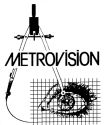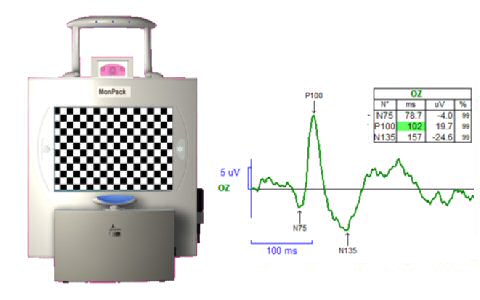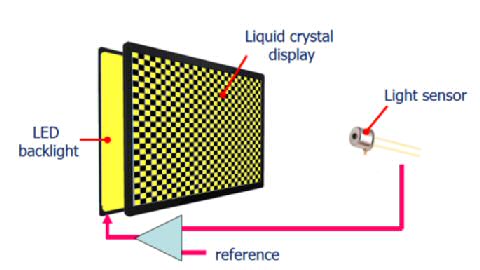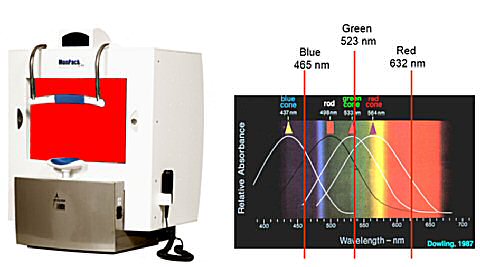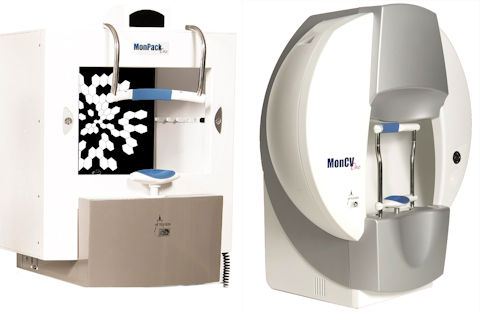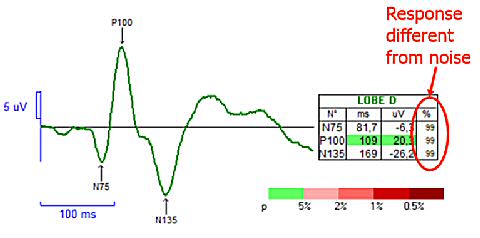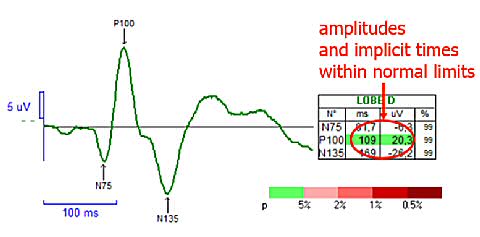ERG and VEP by Metrovision
- Home
- Visual function tests
- vision electrophysiology
- ERG and VEP
Pattern ERG and VEP
Constant luminance cannot be achieved with standard LCD monitors
One important characteristic of pattern stimulations is that the average luminance
should be constant (ISCEV standards for pattern ERG and for pattern VEP).
There should be no change in luminance, even transient when reversing the stimulus or when switching
from the "on" to the "off" pattern.
If constant luminance is not achieved, the PERG stimulus generates a response not only from the
ganglion cells but also from other layers of the retina. In a similar way the PVEP stimulus activates
different types of cortical cells. This may results in a diagnosis error.
Standard LCD monitors produce a transient light flash at each pattern reversal or pattern on-off.
This is due to a different velocity of the liquid crystals between the on-off and off-on transitions.
Pattern ERG and VEP
Metrovision has developped a proprietary technology that generates stimulations with constant luminance.
Metrovision's patented technology involves the use of a LED backlight monitor. A light sensor constantly measures the luminance output and adjusts the backlight in real time so as to achieve constant luminance.
Flash ERG and VEP on MonPackONE
MonPackONE generation of ganzfeld stimulations
In the ganzfeld mode, flashes of light are produced by LEDs from the
backlight and from the surrounding to produce a full field uniform illumination of the eye.
MonPackONE uses LEDs with 3 different wavelengths. Each of them can be programmed over a dynamic
range of 5 log units. They can be combined to produce white light or any combination of 8 million colors.
Flash ERG and VEP on MonCvONE
MonCvONE generation of ganzfeld stimulations
The MonCvONE perimeter, version CR++ can perform the entire ISCEV flash ERG protocol, as a simple
addition to the perimetry testing functions.
In combination with the MonPackONE, it is the most advanced visual function testing system available today.
Flash ERG and VEP on MonColor
MonColor generation of ganzfeld stimulations
Moncolor uses LEds with 5 different wavelengths producing a uniform illumination
of the eye. They can be conbined to produce white light or any combination of 8 billion colors.
It can also generate specific stimulations for the study of S-cone (violet over amber)
and L-cone (deep red) responses.
MonColor can be combined to MonPackONE and MonBaby, resulting in an advanced electrophysiology
unit
Statistical analysis of reliability
The first step in the interpretation of evoked responses is the evaluation of reliability
Metrovision's exclusive test of reliability indicates in a simple way if the response is significantly different from "noise".
Statistical analysis of normality
Comparison with a normal data base
A second step in the interpretation of evoked responses is the comparison with normals.
This is accomplished automatically and the result is given as a color code based on the p-value.
(* normal values are given for a specific set of test parameters. If different parameters are used,
normal values can be defined by the user)
Recent references
PDFExtensive macular atrophy with pseudodrusen-like appearance.
PDFClinical, anatomic, and electrophysiologic evaluation following intravitreal Bevacizumab for macular edema in retinal vein occlusion.
PDFFunctional and high resolution retinal imaging assessment in a case of ocular siderosis.
PDFCongenital nystagmus and negative electroretinography.
PDFRestoration of vision in a large animal model of rod-cone dystrophy.
PDFPsychophysical and electrophysiological testing in ocular hypertension.
PDFAssociation between regular cannabis use and ganglion celldysfunction.
PDFLong-term follow-up of two patients with oligocone trichromacy.
PDFERG and VEP norms on MonPackONE stimulator.
